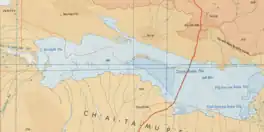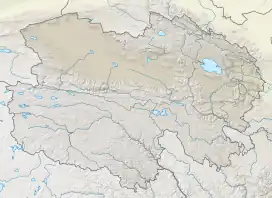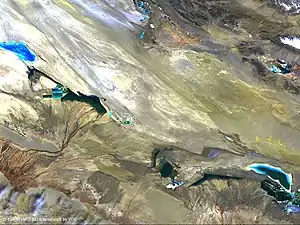Suli Lake
Suli or Senie Lake is a lake in the western Qarhan Playa north of Golmud in the Haixi Prefecture of Qinghai Province in northwestern China. It is fed from the west by the Urt Moron River. Like the other lakes of the surrounding Qaidam Basin, it is extremely saline; like the other lakes of the surrounding Bieletan subbasin, it is rich in lithium. Its underlying salt has also trapped one of China's largest onshore natural gas fields.
| Suli Lake | |
|---|---|
 A map of the Qarhan Playa (1975), with Suli Lake (Se-nieh Hu) in the far west | |
 Suli Lake | |
| Location | Golmud County Haixi Prefecture Qinghai Province China |
| Coordinates | 37°02′06″N 94°18′54.5″E |
| Type | Endorheic saline lake |
| Native name | 涩聂湖 (Chinese) |
| Primary inflows | Urt Moron River |
| Basin countries | China |
| Surface area | 69–85 km2 (27–33 sq mi) |
| Surface elevation | 2,675.6 m (8,778 ft) |
| Suli Lake | |||||||||
|---|---|---|---|---|---|---|---|---|---|
 The Sanhu Depression in 2014, with Suli in central south (ESA) | |||||||||
| Traditional Chinese | 澀聶湖 | ||||||||
| Simplified Chinese | 涩聂湖 | ||||||||
| |||||||||
Name
Suli[1][2] and Sheli[2] are romanizations of the lake's Mongolian name, which derives from a word for "temples" or "sideburns".[3] (Compare Manchu ᡧᡠᠯᡠ, šulu.) Senie[lower-alpha 1] is the pinyin romanization of the Mandarin pronunciation of the name's transcription into Chinese characters.
Geography
Suli Lake lies in the Bieletan subbasin[4] at the western edge of the Qarhan Playa at an elevation of 2,675.6 m (8,778 ft).[1] It is located north of South Suli Lake and northwest of Dabiele Lake.[5] Its area varies from 69–85 km2 (27–33 sq mi).[1] It is fed from the west by the Urt Moron or Utumeiren[6] (t 烏圖美仁河, s 乌图美仁河, Wūtúměirén Hé).[7] Its depth usually does not exceed 1 m (3 ft 3 in).[2]
Geology
Suli's position at the western end of the playa means that its waters are relatively less influenced by the concentrated mineral springs along the playa's northern boundary.[8] Its waters are also less saturated with potassium-rich carnallite than other southern lakes, such as Tuanjie.[9] However, the Bieletan subbasin as a whole—inclusive of S. Suli, Dabiele, and Xiaobiele—is the richest source of brine lithium in China, with an estimated store of 7.74 million metric tons (8.53 million short tons) of lithium chloride.[10] The lithium derives from hot springs located near Mount Buka Daban which now feed the Narin Gol River or Hongshui River[11] (t 紅水河, s 红水河, Hóngshuǐ Hé) that flows into East Taijinar Lake.[12] In the past, however, the springs lay within the "Kunlun" paleolake which until about 30,000 years ago produced a river which flowed north into a broad alluvial fan feeding the "Qarhan" paleolake in the Sanhu area.[13] Bieletan's lithium came both from deposits directly flowing into the area at the time and continuing contributions from the Urt Moron and other rivers arising in and flowing through the former alluvial plain.[14]
North of Suli Lake, the Sebei-1 and Sebei-2 gas fields form China's 4th-largest onshore reserve of natural gas, with production capacity of 4.95 billion cubic meters (175 billion cubic feet) per year. A pipeline connects it directly to Xining and Lanzhou.[15]
History
During the Neogene, tectonic shifts made the bed of Suli Lake the lowest point of the Qaidam Basin, 3,200 m (10,500 ft) below its ridge.[16]
The nearby gas fields were first exploited in 1974.[15]
See also
Notes
- Misspelled Seni by Du & al.[4] and others.
References
Citations
- Zheng (1997), p. 15
- Yu & al. (2001), p. 62.
- WYGP (2019).
- Du & al. (2018), pp. 2–3.
- Yu & al. (2009), p. 2.
- Huang & al. (1997), p. 271.
- Spencer & al. (1990), p. 397.
- Spencer & al. (1990), pp. 398–399.
- Spencer & al. (1990), pp. 404–405.
- Yu & al. (2013), pp. 171–172.
- Yu & al. (2013), pp. 177–178.
- Yu & al. (2013), p. 173.
- Yu & al. (2013), pp. 172–173.
- Yu & al. (2013), p. 182.
- CNPC, p. 19.
- Mao & al. (2017), p. 42.
Bibliography
- "20: Qaidam Basin" (PDF), Brochures, Beijing: China National Petroleum Corporation.
- "Cháidámù Péndì Dìmíng Jíjǐn 柴达木盆地地名集锦" [A Selection of Qaidam Basin Place Names], Official site (in Chinese), Da Qaidam: Wusute Yadan Geological Park, 2 May 2019.
- Du Yongsheng; et al. (April 2018), "Evalutation of Boron Isotopes in Halite as an Indicator of the Salinity of Qarhan Paleolake Water in the Eastern Qaidam Basin, Western China", Geoscience Frontiers, vol. 10, Beijing: China University of Geosciences, pp. 1–10, doi:10.1016/j.gsf.2018.02.016.
- Huang Qi; et al. (1997), "Stable Isotopes Distribution in Core Ck6 and Variations of Paleoclimate over Qarhan Lake Region in Qaidam Basin, China", Chinese Journal of Oceanology and Limnology, vol. 15, Beijing: Science Press, pp. 271–278, doi:10.1007/BF02850884, S2CID 129491899.
- Mao Wenjing; et al. (February 2018), "Discovery and Significance of Quaternary Aqueously Deposited Aeolian Sandstones in the Sanhu Area, Qaidam Basin, China", Petroleum Science, vol. 15, Beijing: China University of Petroleum, pp. 41–50, doi:10.1007/s12182-017-0214-x.
- Spencer, Ronald James; et al. (1990), "Origin of Potash Salts and Brines in the Qaidam Basin, China" (PDF), Fluid-Mineral Interactions: A Tribute to H.P. Eugster, Special Publication No. 2, Geochemical Society.
- Yu Ge; et al. (2001), Lake Status Records from China: Data Base Documentation (PDF), MPI-BGC Tech Rep, No. 4, Jena: Max Planck Institute for Biogeochemistry.
- Yu Junqing; et al., "Geomorphic, Hydroclimatic, and Hydrothermal Controls on the Formation of Lithium Brine Deposits in the Qaidam Basin, Northern Tibetan Plateau, China" (PDF), Ore Geology Reviews, vol. No. 50, Amsterdam: Elvesier, pp. 171–183, doi:10.1016/j.oregeorev.2012.11.001.
- Yu Shengsong; et al. (2009), Chá'ěrhán Yánhé Zīyuán: Kěchíxù Lìyòng Yánjiū 察尔汗盐河资源: 可持续利用研究 [Qarhan Playa Resources: A Study of Sustainable Use] (PDF) (in Chinese), Beijing: Kexue Chubanshe.
- Zheng Mianping (1997), An Introduction to Saline Lakes on the Qinghai–Tibet Plateau, Dordrecht: Kluwer Academic Publishers, ISBN 9789401154581.